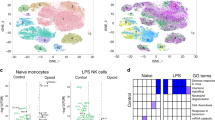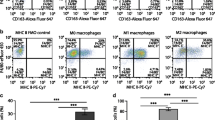Abstract
Background
Our experiments were aimed to test the influence of treatment with different opioids (morphine, fentanyl, methadone) on the humoral and cell-mediated immune responses.
Methods
Mice were treated intraperitoneally (ip) with opioids for several days and next either immunized with sheep red blood cells (SRBC) to test the antibody production or skin-sensitized with hapten picryl chloride (PCL) to induce contact hypersensitivity (CHS). In addition, the effects of opioids on the production of reactive oxygen intermediates (ROIs) and cytokines by peritoneal macrophages (Mf) and on the expression of surface markers on these cells and blood leukocytes were estimated.
Results
Opioids caused an enhancement of ROIs and cytokines production when macrophages were stimulated with zymosan or lipopolysaccharide (LPS) and reduced the expression of antigen presentation markers on Mf. Numbers of anti-SRBC plaque forming cells (PFC) and antibodies titres were lower in mice treated with all tested opioids. Depending on the use of particular opioid and the phase of allergic reaction, effects of the treatment on CHS were diverse. While morphine decreased the early and late phases of induction of CHS responses, methadone increased both reactions. In case of the effector phase of CHS, morphine and fentanyl increased both its early and late stages, while methadone decreased the late reaction. Treatment of recipients with opioids had diverse influence on the passive transfer of CHS in these animals.
Conclusions
Our experiments show that the action of opioids on the immune system is a complex phenomenon dependent on such variables as type of opioid, character of response (humoral versus cellular) and types of cells involved. Here Mf seem to play a significant role.
Similar content being viewed by others
Explore related subjects
Discover the latest articles and news from researchers in related subjects, suggested using machine learning.Abbreviations
- APCs:
-
antigen presenting cells
- CD:
-
cluster of differentiation
- CHS:
-
contact hypersensitivity
- DNFB:
-
1-fluoro-2,4-dinitrobenzene
- DPBS:
-
Dulbecco’s phosphate buffered saline
- FCS:
-
fetal calf serum, FcψR - Fcψ receptor
- FITC:
-
fluorescein isothiocyanate
- IL:
-
interleukin
- LPS:
-
lipopolysaccharide
- Mf:
-
macrophages
- mAb:
-
monoclonal antibody
- NK:
-
natural killer cells
- NMDA:
-
N-methyl-D-aspartate
- Oil-Mf:
-
oil-induced peritoneal macrophages
- OPs:
-
opioids
- OX:
-
oxazolone
- PAMPs:
-
pathogen associated molecular patterns
- PCL:
-
picryl chloride (1,3,5-trinitrophenyl chloride)
- PE:
-
phycoerythrin
- PFC:
-
plaque forming cells
- R-Mf:
-
resident peritoneal macrophages
- ROIs:
-
reactive oxygen intermediates
- SRBC:
-
sheep red blood cells
- TGF:
-
transforming growth factor
- T-Mf:
-
thioglycollate-induced peritoneal macrophages
- TNBSA:
-
trinitrobenzene sulfonic acid
- TNF:
-
tumor necrosis factor
- TNP:
-
2,4,6-trinitrophenyl
- Treg:
-
T regulatory cells
- vs.:
-
versus
References
Bryniarski K, Maresz K, Szczepanik M, Ptak M, Ptak W: Modulation of macrophage activity by proteolytic enzymes. Different regulation of IL-6 and reactive oxygen intermediates (ROIs) synthesis as a possible homeostatic mechanism in the control of inflammation. Inflammation, 2003, 27, 333–340.
Bryniarski K, Szczepanik M, Maresz K, Ptak M, Ptak W: Subpopulations of mouse testicular macrophages and their immunoregulatory function. Am J Reprod Immunol, 2004, 52, 27–35.
Bryniarski K, Szczepanik M, Ptak M, Ptak W: The influence of collagenase treatment on the production of TNF-α, IL-6 and IL-10 by testicular macrophages. J Immunol Methods, 2005, 301, 186–189.
Bryniarski K, Szczepanik M, Ptak M, Zemelka M, Ptak W: Influence of cyclophosphamide and its metabolic products on the activity of peritoneal macrophages in mice. Pharmacol Rep, 2009, 61, 550–557.
Carr DJ: The role of endogenous opioids and their receptors in the immune system. Proc Soc Exp Biol Med, 1991, 198, 710–720.
Chuang TK, Killam KF Jr, Chuang LF, Kung H-F, Sheng WS, Chao CC, Yu L et al.: Mu opioid receptor gene expression in immune cells. Biochem Biophys Res Commun, 1995, 216, 923–930.
Cunningham AG, Szenberg A: Further improvements on the plaque technique for detecting single antibody forming cells. Immunology, 1968, 14, 599–600.
Delgado-Velez M, Lugo-Chinchilla A, Lizardo L, Morales I, Robles Y, Nimaris B, Rodriguez JW et al.: Chronic exposure of human macrophages in vitro to morphine and methadone induces a putative tolerant / dependent state. J Neuroimmunol, 2008, 196, 94–100.
Elliott JC, Picker MJ, Nelson Ch J, Carrigan KA, Lysle DT: Sex differences in the opioid-induced enhancement of contact hypersensitivity. J Invest Dermatol, 2003, 121, 1053–1059.
Hogen Esch AJ, van der Heide S, Van der Brink W, Van Ree Bruynzeel DP, Coenraads PJ: Contact allergy and respiratoty/mucosal compliants from heroin (diacetyl-morphine). Contact Dermatitis, 2001, 45, 42–49.
Iwamoto ET, Martin RW: Multiple opioid receptors. Med Res Rev, 1981, 1, 411–440.
Kaplan DH, Igyarto BZ, Gaspari AA: Early immune events in the induction of allergic contact dermatitis. Nat Rev Immunol, 2012, 12, 114–124.
Krajnik M, Schäfer M, Sobanski P, Kowalewski J, Bloch-Boguslawska E, Zylicz Z, Mousa SA: Local pulmonary opioid network in patients with lung cancer: a putative modulator of respiratory function. Pharmacol Rep, 2010, 62, 139–149.
Lefkowitz SS, Chiang CY: Effects of certain abused drugs on hemolysin forming cells. Life Sci, 1975, 17, 1763–1768.
Limiroli E, Gaspani L, Panerai AE, Sacerdote P: Differential morphine tolerance development in the modulation of macrophage cytokine production in mice. J Leukoc Biol, 2002, 72, 43–48.
Ma J, Wang J, Wan J, Charboneau R, Chang Y, Barke RA, Roy S: Morphine disrupt interleukin-23 (IL-23)/IL-17-mediated pulmonary mucosal host defense against Streptococcus pneumoniae infection. Infect Immun, 2010, 78, 830–837.
Mishell B, Mishell R: Primary immunization in suspension cultures. In: Selected Methods in Cellular Immunology. Eds. Mishell BB, Shiigi SM, WH Freeman & Company, San Francisco, 1980, 30–37, 86–93.
Nelson CJ, How T, Lysle DT: Enhancement of the contact hypersensitivity reaction by acute morphine administration at the elicitation phase. Clin Immunol, 1999, 93, 176–183.
Nelson CJ, Lysle DT: Involvement of substance P and central opioid receptors in morphine modulation of the CHS response. J Neuroimmunol, 2001, 115, 101–110.
Nelson CJ, Lysle DT: Morphine modulation of the contact hypersensitivity response: characterization of immunological changes. Clin Immunol, 2001, 98, 370–377.
Pichler WJ: Delayed drug hypersensitivity reactions. Ann Intern Med, 2003, 139, 683–693.
Posadas SJ, Pichler WJ: Delayed drug hypersensitivity reactions — new concepts. Clin Exp Allergy, 2007, 37, 289–299.
Ptak W, Bryniarski K, Ptak M, Majewska M, Gamian A, Lobo FM, Szczepanik M: Toll-like receptor ligands reverse suppression of contact hypersensitivity reactions induced by epicutaneous immunization with protein antigen. Int Arch Allergy Immunol, 2006, 139, 188–200.
Sacerdote P: Opioid-induced immunosuppression. Curr Opin Support Palliat Care, 2008, 2, 14–18.
Shahabi NA, Sharp BM: Antiproliferative effects of delta opioids on highly purified CD4+ and CD8+ murine T cells. J Pharmacol Exp Ther, 1995, 273, 1105–1113.
Sirohi S, Dighe SV, Walker EA, Yoburn BC: The analgesic efficacy of fentanyl: relationship to tolerance and μ-opioid receptor regulation. Pharmacol Biochem Behav, 2008, 91, 115–120.
Stannard C, Coupe M, Pichering T: Opioids in non-cancer pain. Oxford University Press Inc., New York, 2007.
Stanojevic S, Vujic V, Mitric K, Kustrimovic N, Kovacevic-Jovanovic V, Miletic T Dimitrievic M: Methionine-enkephalin modulation of hydrogen peroxide (H2O2) release by rat peritoneal macrophages involves different types of opioid receptors. Neuropeptides, 2008, 42, 147–158.
Szczepanik M, Akahira-Azuma M, Bryniarski K, Tsuji RF, Kawikova I, Ptak W, Kiener C et al.: B-1 B cells mediate required early T cell recruitment to elicit protein-induced delayed-type hypersensitivity. J Immunol, 2003, 171, 6225–6235.
Szczepanik M, Bryniarski K, Pryjma J, Ptak W: Distinct population of antigen-presenting macrophages are required for induction of effector and regulatory cells in contact sensitivity in mice. J Leukoc Biol, 1993, 53, 320–326.
Szczepanik M, Bryniarski K, Tutaj M, Ptak M, Skrzec-zynska J, Askenase PW, Ptak W: Epicutaneous immunization induces αβ T cell receptor CD4 CD8 double-positive non-specific suppressor T cells that inhibit contact sensitivity via transforming growth factor-p. Immunology, 2005, 115, 42–54.
Thomas J, von Gunten CF: Pharmacologic therapies of pain in current diagnosis and treatment of pain. Lange Mc Graw-Hill Companies Inc., New York, 2006.
Vallejo R, de Leon-Casasola O, Benyamin R: Opioid therapy and immunosuppression. Am J Ther, 2004, 11, 354–365.
Vassou D, Bakogeorgou E, Kampa M, Dimitriou H, Hatzoglou A, Castanas E: Opioids modulate constitutive B-lymphocyte secretion. Int Immunopharmacol, 2008, 8, 634–644.
Vujic V, Stanojevic S, Dimitrijevic M: Methionine-enkephalin stimulates hydrogen peroxide and nitric oxide production in rat peritoneal macrophages: interaction of mi, delta and kappa opioid receptors. Neuroimmunomodulation, 2004, 11, 392–403.
Yahya MD, Watson RR: Immunomodulation by morphine and marijuana. Life Sci, 1987, 41, 2503–2510.
Walsh D (Ed.): Palliative medicine. Saunders Elsevier, Philadelphia, 2009.
Watson M, Lucas C, Hoy A, Wells J: Oxford Handbook of palliative care. Oxford University Press Inc., New York, 2009.
Author information
Authors and Affiliations
Corresponding author
Rights and permissions
About this article
Cite this article
Filipczak-Bryniarska, I., Nowak, B., Sikora, E. et al. The influence of opioids on the humoral and cell-mediated immune responses in mice. The role of macrophages. Pharmacol. Rep 64, 1200–1215 (2012). https://doi.org/10.1016/S1734-1140(12)70916-7
Received:
Revised:
Accepted:
Published:
Issue Date:
DOI: https://doi.org/10.1016/S1734-1140(12)70916-7




